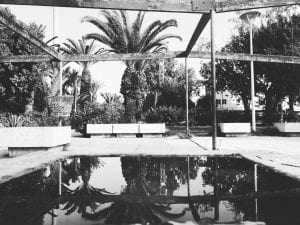Foreign lands and foreign times are called upon in Pace, London’s latest exhibition; Faux Guide by Ydo Barrada. The ground floor gallery, located in the prestigious Royal Academy, bombastically blurs the line between collecting, hoarding, sociology and archaeology. The viewer is transported to a place between the Atlas Mountains and Sahara Desert. Conceived around Barrada’s latest video, which lends its name to the exhibition title, Faux départ (False Start) (2015), the viewer is taken on a journey across this landscape – its barren, after-gold-rush emptiness and dustiness provides a serene setting for the various creative perpetrators that inhabit it, hustling their way by fabricating false fossils and exploiting history.
In the centre of the gallery, carpets of blue, yellow, green and red overlap and create an inaccessible space. The walls, coordinated with the same colours, give the impression of abstract market stalls, or even highlighted geopolitical tropes. The perimeter of the gallery is crammed with items from this plundered region, referencing its exploited existence in a darkly comic manner. This is evidenced in Second hand Stegosaurus (hand painted in the Philippines; shown at the Natural History Museum, Canberra, Australia; sold at the The Tuscon Gem and Mineral Show 2014) (2015), a scale model dinosaur in a shipping crate. Gargantuan and unexpected, its place within the exhibition as opposed to its provenance appears to blur lines between artefact and novelty item.
At the same time the exhibition becomes a place where Barrada counter-hustles. A particularly intriguing example on a plinth is Untitled (stones shaped by erosion, found in El Abid Rivière [The Slave River] which has been commodified. Nearby, Untitled (Cast of Moha M’Ghri’s hand], retired fossil preparatory) (2015) utilises Barrada’s platform of the gallery to create a vehicle in which to hustle the hustlers. A mauve coloured plinth, Plumber Assemblage (2015), has on it a battered and rusted hose contraption. It becomes the pinnacle of Barrada’s hustle. In Untitled (Dinosaur Road Series; Red Beds, High Atlas, Middle Atlas, Morocco) (2013-15), four pale, wooden framed images showing the natural beauty of the landscape are located above the contraption. The juxtaposition between the two shows just how exploitative mankind can be. Similar groupings of images, advertisements and plinths with fossil cleaning devices litter the mauve section.
In Museum Vitrine, collection of fakes and shapes (2015), a cabinet is filled with fakes and fossils that can be peered at through drawers seemingly opened out of curiosity. In one can be found scribbled in anarchic patriotism “Miss Colorado and Miss Finland are Moroccan.” This vivaciously absurd refrain, along with the film piece which is playing on loop, emphasises so emphatically just how easy it is to take advantage of people’s nationality.
Barrada equates the act of collecting by scientists and ethnographers to that of a museum curator. There is a duty to uphold a standard of truthfulness in the acquisition of artefacts that have the capacity to shape history, yet there are also cases within the art world where this responsibility is bypassed and where an artist’s output may be exploited for immediate financial reward. Barrada is clearly calling into question motives behind wanting, or even desiring certain pieces, causing the viewer to question how and why these objects become works of art merely by being placed in a gallery.
William Davie
Yto Barrada: Faux Guide, until 8 August, Pace, 6 Burlington Gardens, London W1S 3ET.
Explore the show at www.pacegallery.com.
Follow us on Twitter @AestheticaMag for the latest news in contemporary art and culture.
Credits
1. Yto Barrada, Faux Guide installation view, 2015. Courtesy of the artist and Pace London.





